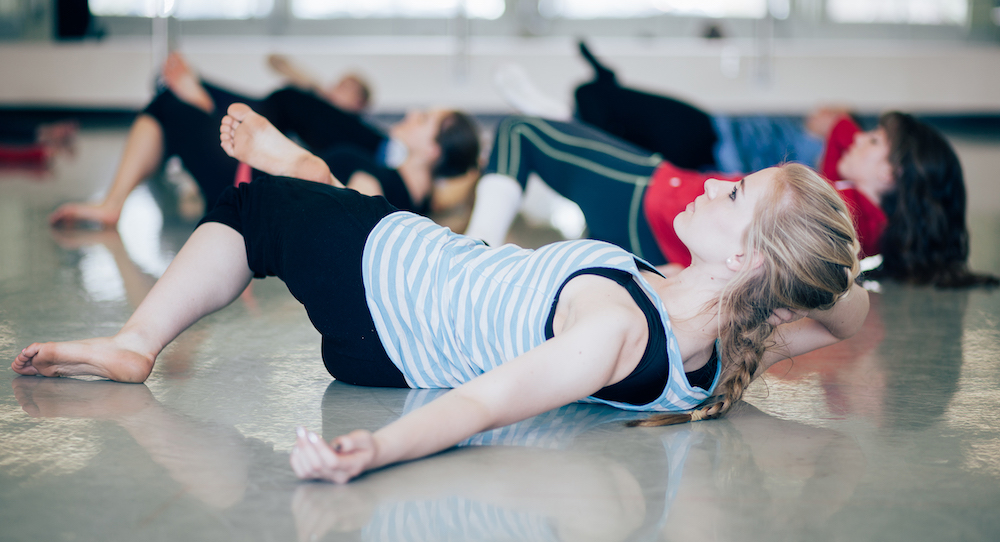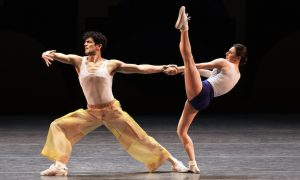Formal dance training includes much about patterns in the body: the sequential arcs of port de bras, common step sequences such as a pas de bourrée, the actions in the body that lead to a pirouette. The question may be how much these patterns align, or don’t align, with the inherent anatomical and physiological patterns in the body. The SAFE® Method, including SAFE® FLOOR and SAFE® BARRE, is the brainchild of former Berlin Opera Ballet Principal Dancer Alexandre Munz (trained at the Paris Opera Ballet). It’s a way for dancers to find the movement patterns that are more natural for the human body — bringing healing, greater wellness, and enhanced artistry.
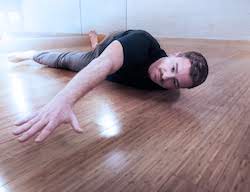
Alexandre Munz. Photo courtesy of Maison Munz.
Dance Informa speaks with Munz, as well as his protégé Sanchit Babbar (the first SAFE® FLOOR certified coach in the U.S.) to learn more about the somatic practice and what it can offer dancers. For Munz, it all started out of necessity. “I was desperate,” he explains, rigorous ballet training and performance having brought spinal issues significant enough that surgery seemed imminent. Munz very much wanted to avoid going under the knife, however, and started digging deeper into his own body.
He began at the barre, épaulement leading into spirals through the neck into the shoulders, through the spine and into the hips. This evolved into what would be SAFE® BARRE, “a barre training articulating ballet with modern biomechanics.” Exhaustion and resignation led him to the floor, where he found variations on these spirals and other intuitive movement patterns. This would become SAFE® FLOOR, “a spine and spinal cord workout.”
Munz reports having felt better almost immediately. He began codifying the form and then bringing it to dance companies in Germany, France, Sweden and elsewhere in Europe. In France, he encountered resistance to new ways of approaching technique and thinking about movement in general. So, he decided to bring his form and enterprise to America. He’s found much more openness to innovation and experimentation here, he shares.
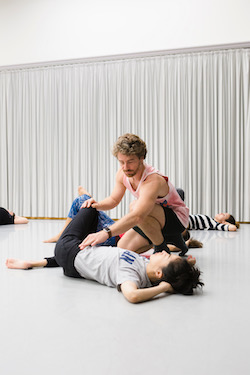
SAFE® Method. Photo by Jessica Schaefer.
In one way, the SAFE® Method is radical, considering the way structured movement is generally approached in western culture. In another way, it’s rooted in something essential and fundamental to being human; the exercises recreate developmental movement patterns, as well as those aligning with our shared, innate anatomy and physiology.
Much of the work is segmented into individual body parts. The exercises of SAFE® FLOOR are also repeated four to eight times, very slowly. All of this helps practitioners key into sensation within various body parts, and solidify optimal patterns of movement within them. “Micro-spherical movements are performed in a spiral and in slowness, [which] strengthens the deepest muscle layers,” Munz explains. Tension can be detected and, with guidance from an instructor, gradually released — in only one session.
Munz describes how this release happens through the “sponge strategy”, which “massages and regenerates the fascia, [the] connective tissues [that] govern our organs and our systems.” A 2011-12 national experiment sponsored by the French ministry of culture, led by Tiphanie Vennat (a renowned Psychomotor expert) and Munz, found that SAFE® also decompresses the joints, stretches muscles with no pain and increases flexibility, reinforces the core.

Sanchit Babbar.
Babbar is a clear example of what SAFE® can do for dancers. While dancing the principal role of Mowgli in Oakland Ballet’s The Jungle Book (after dancing with Vorpommern Ballet Germany), he fractured the fifth metatarsal in his right foot while landing a grand jeté. Through social media, he found Celine Cassone, the only certified SAFE® teacher in Canada and principal dancer with Les Ballets Jazz De Montréal. Babbar connected with Munz and took his first class, after which he felt an immediate difference. “I realized that this was what I’ve been looking for, and didn’t realize it.” The first way it assisted him was with recovery from injury, which — interestingly — was more psychological than physical.
“SAFE® made me realize that nothing’s wrong with me, that I have within me what I needed to heal, that I just had to change my patterns and my thoughts,” Babbar notes. Cautiously, with guidance from a doctor, he tested what he could do and challenged himself. For instance, he was eventually able to fully relevé by relaxing through the toes and ball of his feet (the injured one, as well), as well as lifting up through the core to take pressure off the feet — from information SAFE® had offered him. Babbar also describes his artistry deepening, having found deeper connections and freedom in his movement.
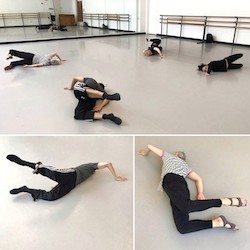
SAFE® Method. Photo courtesy of Sanchit Babbar.
He became certified to teach SAFE® FLOOR, the first in the U.S., and is now teaching the form (as well as dance) throughout New York City. Thus far, he’s taught several big names in dance. Deborah Wingert Arkin (head faculty of Manhattan Youth Ballet and at The Juilliard School, teacher at The School of American Ballet, and George Balanchine répétiteur for The George Balanchine Trust) attests that “my spine feels mobile, supple and alive. The energy I have is palpable, and I feel more space between my joints. And I learned a great deal about the tension I hold in my tongue, neck and throat.” Likewise, Andy LeBeau, rehearsal director for Paul Taylor Dance Company, says, “Wow, I think I need to do this every morning. I feel taller and taller.”
Clifton Brown, dancer with Alvin Ailey American Dance Theater, attests that “dance has so many active demands on the body, but SAFE® FLOOR is a calming, intuitive system that can help heal and restore simple constructive movement patterns…[that’s] instrumental in releasing unnecessary tension while facilitating ease of motion.” Babbar also taught Mimi Paul, in the original cast of Balanchine’s most popular ballet, Jewels. Munz, for his part, taught Wendy Whelan, arguably the most famous American ballerina alive.
Munz shares how the SAFE® techniques have had arguably life-changing experience for non-dancers as well. “[The method] is a natural anti-inflammatory for internal organs, which explains why so many of our customers around the world report they cancelled their surgery, their medication or their injections,” he describes. Whether dancer or not, this method seems to have the potential to connect one to their strongest, most integrated body and way of moving.
To learn more, go to www.maisonmunz.com/safefloor_en.html.
By Kathryn Boland of Dance Informa.


